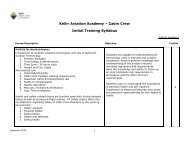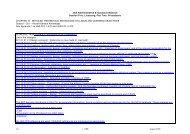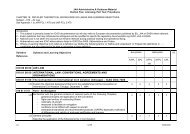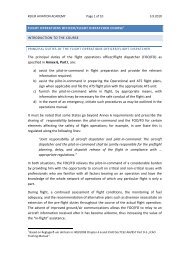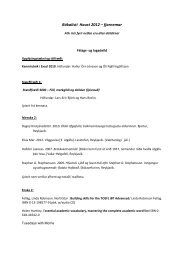RNAV Training Manual - Keilir
RNAV Training Manual - Keilir
RNAV Training Manual - Keilir
Create successful ePaper yourself
Turn your PDF publications into a flip-book with our unique Google optimized e-Paper software.
How does GPS work?<br />
1. Overview of the system s three segments<br />
The Master Control Station feeds<br />
back a navigational update to each<br />
satellite satellite, synchronising its internal<br />
clock and adjusting the ephemeris<br />
model of its orbit<br />
Occasional maneuvers are<br />
commanded which maintain a<br />
satellite in its proper orbit<br />
Control Segment (CS)<br />
A Master Control Station in Colorado and 4<br />
Monitor stations across the globe<br />
They establish the exact orbital position of<br />
each satellite, and maintain the reference<br />
atomic clocks for the system<br />
Space Segment (SS)<br />
The system is designed for a minimum of 24 satellites (abbreviated as SV , Satellite Vehicle):<br />
4 in each of 6 orbital planes, at a height of ~20,000km and completing one orbit every 12hrs<br />
P A<br />
Currently there are 31 satellites, the 7 additional ones improve accuracy and resilience. The<br />
constellation is arranged so that at least 6 satellites are always line-of-sight visible from almost<br />
any point on the Earth<br />
Th The llocation ti of f the th GGround d Stations St ti<br />
is very accurately established and<br />
used to calibrate the satellites<br />
position and clock data based on<br />
the navigation messages they send<br />
Each satellite broadcasts a ranging code , used<br />
to establish distance from the GPS receiver, and<br />
its own Navigation Message containing<br />
Clock data at the time of transmission<br />
Data on the satellite s orbital position<br />
( ephemeris )<br />
Almanac data on the status of the entire<br />
satellite network<br />
(detailed in following pages)<br />
User Segment (US)<br />
Navigation devices which typically include<br />
an antenna, an accurate clock, receiver,<br />
processor and control/display components<br />
Modern multi-channel receivers can<br />
simultaneously monitor 12-20 satellites<br />
The receipt p of ranging g g codes and navigation g messages g from multiple p satellites<br />
allows GPS Receivers to compute accurate 3D position, speed and time<br />
40



